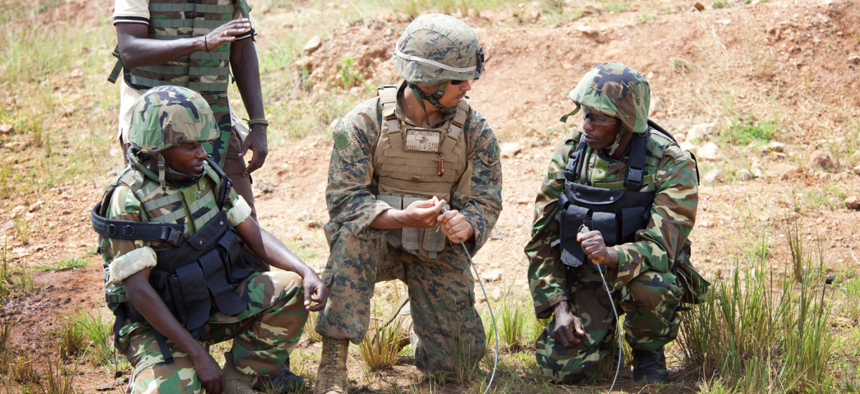
A U.S. Marine from the Special-Purpose Marine Air-Ground Task Force Africa demonstrates combat engineer skills for Burundi National Defense Forces personnel. U.S. Army/Senior Airman Rachel Waller
‘Light Footprint’ Operations Keep US Troops in the Dark
With fewer troops to gather intelligence, American forces are vulnerable to locals’ manipulation.
Scarred by the economic and political legacy of the prolonged wars in Afghanistan and Iraq, the United States and its Western allies have become reluctant to deploy their own troops in significant numbers. Instead, smaller groups are deployed, and their primary roles are not to engage directly in combat, but to provide training, air support, or intelligence to local and regional forces who do the bulk of the front-line fighting. This type of engagement — which we at the Oxford Research Group refer to as “remote warfare” but which is also popularly known as “light footprint warfare” — is seen as less risky to Western troops, military budgets, and political reputations.
This is not entirely true. The risks of remote warfare, different from those seen in previous engagements, are understudied and generally under-estimated. A prime example is the gathering of intelligence. With fewer U.S. troops on the ground, it becomes harder to independently verify intelligence. Instead, they must rely on local partners and sources, who can present untrue, misleading, or manipulated information.
An example: On Sept. 6, Somali forces raided the family home and farm of former President Aden Abdullah Osman Daar, detaining three teenage members of his family. The raid was ostensibly a Somali effort — officials from U.S. Africa Command say American troops played only a supporting role — but witnesses described the apparent commander of the soldiers as “a tall white man who spoke American English.” In its wake, the prominent Daar family expressed outrage, Prime Minister Hassan Ali Khaire apologized, and experts have warned that raiding the home of a well-respected Somali civilian may have fueled public support for the Al-Shabaab extremist group and undermined U.S. counter-terrorism efforts.
The cause of the disastrous raid appears to have been “bad intelligence during and before the raid,” gathered by locals who seem to have used the opportunity to draw the American military into local clan feuds. One Somali intelligence officer involved suggested that the Americans “relied on false intelligence gathered by local informants who are sometimes biased due to clan influence.”
Related: The ‘War on Terror’ Still Grows in Somalia
Related: Afghanistan: It’s Only Getting Worse
Related: The US Military Must Lighten Warfighters’ Loads
A one-off mistake? Sadly, the raid forms part of a larger pattern in which U.S. forces are drawn into local sectarian conflicts through subjective intelligence provided by local sources. In May, for example, a joint U.S.-Somali raid resulted in the deaths of five Somalis. While government sources claim three of the dead were senior militants, the names of the militants sought and those killed do not match, and witnesses on the ground describe them as farmers of bananas and cattle. The sum total of resistance appears to have been one individual who fired several shots because he believed the village was being attacked by a rivalling clan, but threw away his weapon when he was wounded.
Similarly, in August 2017, another joint U.S.-Somali raid meant to target Al-Shabaab fighters led to the deaths of 10 civilians including a child. The soldiers later discovered that Al-Shabaab had already been driven out of the city by Somali forces. An investigation into the raid by an American journalist found witnesses who believed the U.S. had been working with a clan in renewed inter-clan tensions. Experts said it seemed that the U.S. “had been drawn into local clan dynamics.”
Inherent part of Remote Warfare?
Without troops on the ground, it becomes more dangerous to rely on local intelligence. In my own organization, the Remote Warfare Programme, we have explored some of the risks and challenges of remote warfare over the last 18 months through expert roundtables with the military, the government, civil society and academia, as well as field research in Iraq, Afghanistan, Mali, Kenya and with personnel rotating out of Somalia. We concluded that light-footprint engagements make it difficult to set up meaningful connections with local contacts, or even to confirm intelligence received from local sources. This creates a serious problems for counter-terrorism activities, especially because “the precision strikes that Western powers can provide in support of their partners are only as precise as the intelligence that informs them.”
Instead of addressing this issue, recent developments in U.S. foreign policy are likely to exacerbate this challenge in coming years. Following the deaths of four U.S. Special Operations Forces in Niger late last year, the Pentagon has announced that it is considering withdrawing nearly all American commandos from Niger, as well as closing military outposts in Tunisia, Cameroon, Libya, and Kenya. At the same time, the U.S. plan to open another drone base and President Trump has granted the CIA and the U.S. military broader powers to execute high-risk counter-terrorism air strikes and raids in Somalia after he declared parts of the country “temporary battlefields”. As a result of these developments, the U.S. is likely to be forced to rely more than ever on local sources, who they do not fully know or understand, to conduct high-risk raids that are more easily approved.
If this challenge is not recognized and addressed, the U.S. and other Western troops may continue to be drawn into local power dynamics, which will—at best—obscure and complicate the troops’ actual missions and—at worst—sow further instability and conflict in the places in which the U.S. intervenes.



